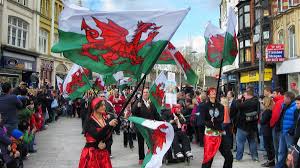St. David’s Day, celebrated on March 1st each year, is a vibrant and important occasion for the people of Wales and for Welsh communities worldwide. This day commemorates St. David, the patron saint of Wales, whose legacy is celebrated with a deep sense of pride and cultural significance. But how did this day come to be, and what does it mean for those who observe it? Let’s explore the history and traditions surrounding St. David’s Day.
The Legend of St. David
St. David, or Saint Dewi, is believed to have lived during the 6th century, though the exact dates of his life remain unclear. According to Welsh legend, St. David was a remarkable monk, abbot, and preacher, credited with spreading Christianity throughout Wales. He was said to have founded several monastic communities, and his most notable foundation was Glyn Rhosyn, now known as St. Davids in Pembrokeshire, Wales. This area became a major center of Christian worship and pilgrimage during the medieval period.
The most enduring and widely celebrated story of St. David comes from the Llyfr Gwydr, a manuscript written in the 12th century. According to the legend, St. David’s teachings and devotion to Christianity inspired many to follow his example. One of the most famous accounts describes him preaching to a large crowd, where, in a moment of divine intervention, the ground beneath him rose up to form a hill, allowing the crowd to hear him more clearly. This miraculous event led to the hill becoming known as Mynydd Dewi, or the “Hill of David,” in the Pembrokeshire area.
Despite the passage of time, St. David’s influence remained strong throughout Welsh history, particularly as Christianity spread across the British Isles. In fact, the oldest surviving reference to the feast day of St. David dates back to the 9th century, with official recognition coming later, in the 12th century.

The Establishment of St. David’s Day
St. David’s Day has been celebrated as early as the 12th century, though it was not officially established as a national holiday until much later. In the Middle Ages, St. David’s Day was a significant day of pilgrimage, with many people traveling to the town of St. Davids to pay homage to their patron saint. During this period, the day was marked by religious observances, including mass and feasts, as well as various activities honoring the life of St. David.
In 2000, St. David’s Day received formal recognition by the Welsh Parliament, marking a new chapter in its celebration. Although it is not a public holiday in the same way as St. Patrick’s Day in Ireland, St. David’s Day continues to hold cultural and symbolic significance for the Welsh people, both at home and abroad.
Celebrating St. David’s Day: Traditions and Symbols
St. David’s Day is steeped in rich Welsh traditions that highlight the country’s history, culture, and identity. A key aspect of the celebrations is the wearing of traditional symbols of Wales, including the daffodil and leek. These symbols have deep-rooted connections to Welsh history.

The daffodil, which blooms in early spring, is often worn by Welsh people on St. David’s Day as a symbol of national pride and unity. The leek, on the other hand, is another prominent Welsh symbol, historically associated with St. David himself. It is said that St. David instructed his followers to wear leeks to distinguish themselves from their enemies, as a form of both identification and protection. In fact, the leek is so central to Welsh culture that it is even featured in the Welsh national rugby team’s uniform.
In addition to wearing these symbols, Welsh people often participate in a variety of festivities to celebrate the day. These can include parades, concerts, and performances of Welsh folk music and dance. Schools and communities hold special events, with children often dressing in traditional Welsh costumes, which typically include a long skirt, apron, shawl, and bonnet for girls, and a Welsh tweed cap for boys. Folk songs, such as Hen Wlad Fy Nhadau (the Welsh national anthem), are sung with great pride during these gatherings.
Another St. David’s Day tradition is the Eisteddfod, a festival of Welsh music and poetry. While the Eisteddfod is held annually, the St. David’s Day celebrations often feature performances from local poets, musicians, and artists. This is a wonderful opportunity to honor the rich literary and artistic heritage of Wales.
The Role of St. David’s Day in Modern Wales
In modern times, St. David’s Day remains a reflection of Wales’ identity and its continued celebration of culture, history, and language. For the Welsh diaspora, this day offers an opportunity to reaffirm their connection to Wales, whether through hosting parades, gatherings, or simply by participating in Welsh traditions.
In addition, the day has gained increasing recognition and support from the Welsh Government, which sees it as an important occasion to celebrate Wales’ unique identity within the United Kingdom. Political leaders and public figures use St. David’s Day to promote Welsh language, culture, and heritage, as well as to advocate for the continued preservation of these aspects of Welsh life.
For those living outside Wales, St. David’s Day offers an opportunity to showcase Welsh culture on the global stage. Welsh communities in countries such as the United States, Canada, Australia, and South Africa host their own events to mark the day, including performances of Welsh music and the reading of Welsh poetry, further strengthening the international presence of Welsh heritage.
Conclusion
St. David’s Day is a celebration of more than just a religious figure. It represents the enduring spirit of Wales and its people. From the legend of St. David and the miraculous hill he stood upon, to the national symbols like the daffodil and leek, this day has remained an important part of Welsh life for centuries. As a day that brings people together to celebrate culture, history, and pride, St. David’s Day is not only a tribute to a beloved saint but also a vibrant reminder of the rich and enduring legacy of Wales.
